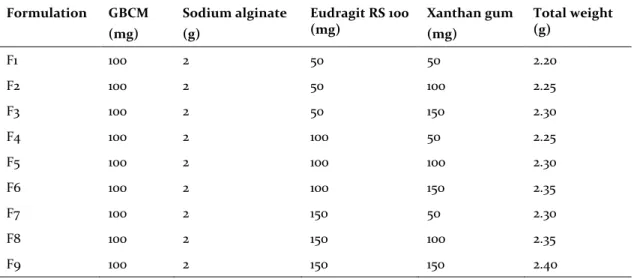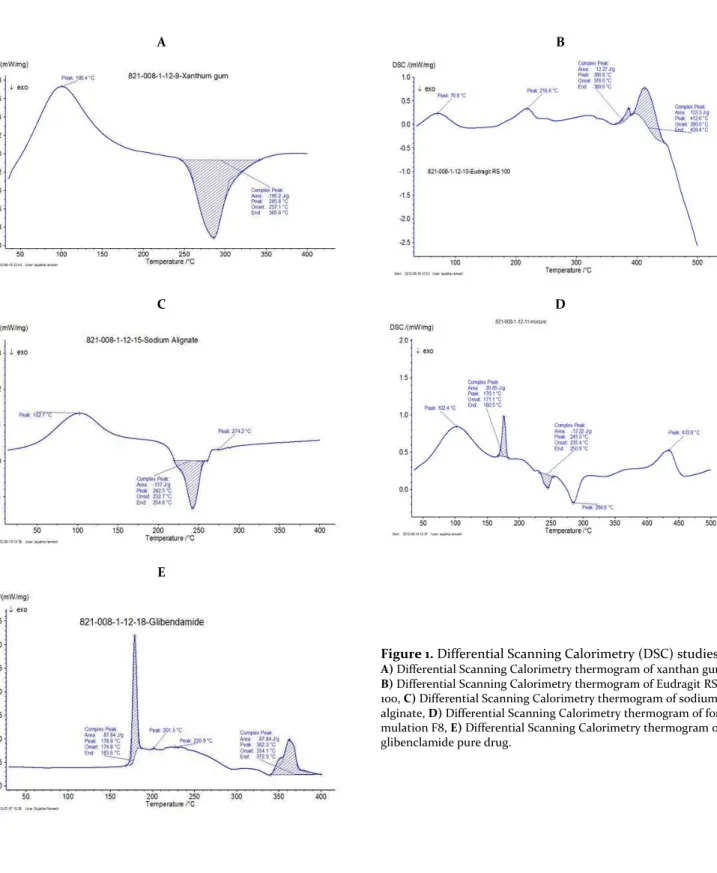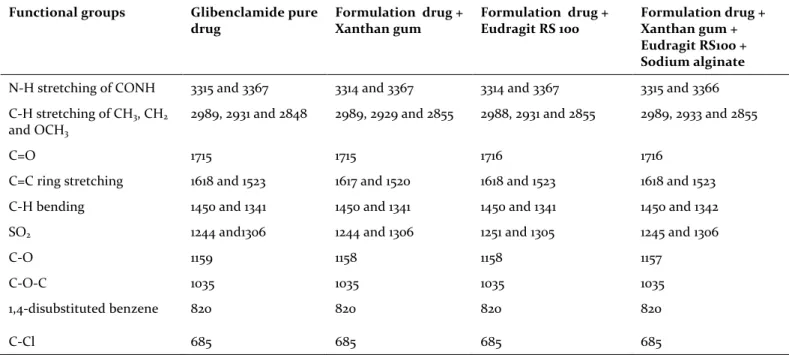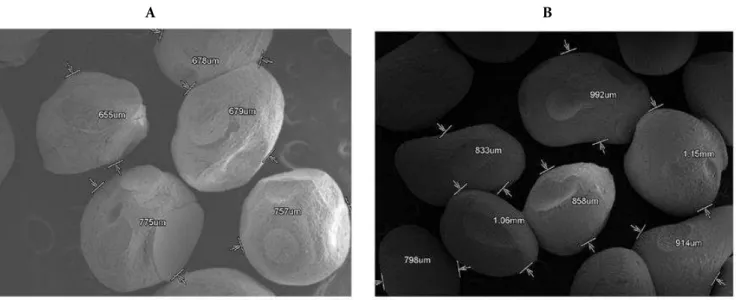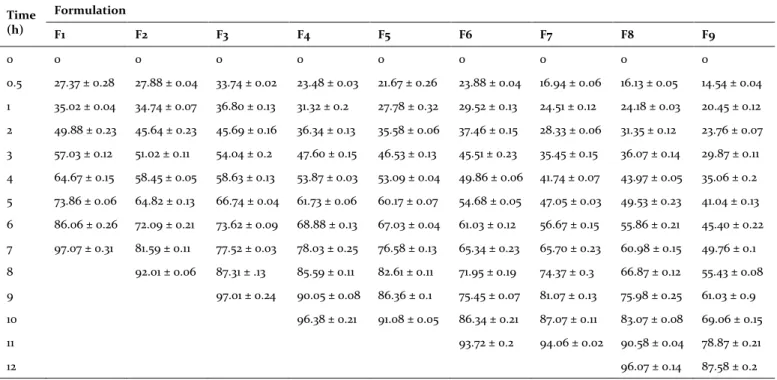ISSN 0719-4250
http://jppres.com/jppres
Original Article | Artículo Original
_____________________________________
Evaluation of glibenclamide microspheres for sustained release
[Evaluación de microesferas de glibenclamida para liberación sostenida]
Kambham Venkateswarlu*
Department of Pharmaceutics, JNTUA Oil Technological and Pharmaceutical Research Institute, Ananthapuramu, Andhra Pradesh-515001, India. *E-mail: k.v.pharmacy@jntua.ac.in
Abstract Resumen
Context: Sustained release drug delivery systems are more preferred than the conventional drug delivery systems due to its enhanced bioavailability and patient compliance. Earlier studies reported on glibenclamide (GBCM) were not clear and hence, the step has been taken to explore the sustained release drug delivery system of GBCM.
Aims: To evaluate the sustained release microspheres obtained of GBCM. Methods: Microspheres were prepared by ionic gelation method using the polymers like Eudragit RS 100 and xanthan gum. Polymers can sustain the drug release from microspheres. The prepared microspheres were subjected to micromeritic studies like Carr s index, Hausner s ratio and angle of repose.
Results: Micromeritic studies confirmed that the microspheres possessing acceptable flow properties. It was observed from the in vitro release studies, formulations F8 and F9 showed sustained drug release for desired time of 12 h and when compared to F9, formulation F8 showed maximum drug release for 12 h.
Conclusions: Results confirmed the formulation F8 consist of the polymers such as Eudragit RS 100 about 150 mg and xanthan gum about 100 mg showed desired sustained release of 12 h with 96.07% and kinetic studies confirmed that the release from microspheres followed non-Fickian diffusion mechanism. Due to its sustained release property, it could enhance the bioavailability of drug thereby improves the patient compliance and expect better treatment than conventional dosage forms.
Contexto: Los sistemas de suministro de fármacos de liberación sostenida son más preferidos que los sistemas convencionales de administración debido a su mejor biodisponibilidad y al cumplimiento del paciente. Los estudios anteriores sobre glibenclamida (GBCM) no fueron claros, por lo que se decidió explorar el sistema de liberación sostenida de fármacos de GBCM.
Objetivos: Evaluar las microesferas de acción sostenida obtenidas de GBCM.
Métodos: Las microesferas se prepararon mediante un método de gelificación iónica con polímeros como Eudragit RS 100 y goma xantano. Los polímeros pudieron sostener la liberación del fármaco a partir de microesferas. Las microesferas preparadas se sometieron a estudios micromeríticos como el índice de Carr, la relación de Hausner y el ángulo de reposo.
Resultados: Los estudios microméríticos confirmaron que las microesferas poseen propiedades de flujo aceptables. Se observó, a partir de los estudios de liberación in vitro, que las formulaciones F8 y F9 mostraron una liberación sostenida del fármaco durante un tiempo deseado de 12 horas y cuando se comparó con F9, la formulación F8 mostró liberación máxima del fármaco durante 12 h.
Conclusiones: Los resultados confirmaron que la formulación F8 constituida de polímeros tales como Eudragit RS 100 (150 mg) y goma xantano (100 mg) mostró una liberación sostenida deseada de 12 h con 96,07% y estudios cinéticos confirmaron que la liberación de microesferas seguía mecanismo de difusión no Fickiano. Debido a su propiedad de liberación sostenida, esta podría mejorar la biodisponibilidad del fármaco, por lo tanto, mejorar el cumplimiento del paciente y se esperaría un mejor tratamiento que las formas de dosificación convencionales.
Keywords: Eudragit RS 100; glibenclamide; ionic gelation method; sustained release; xanthan gum.
Palabras Clave: Eudragit RS 100; glibenclamida; goma xantano; liberación sostenida; método de gelificación iónica.
ARTICLE INFO
Received | Recibido: September 2, 2016.
Received in revised form | Recibido en forma corregida: October 18, 2016. Accepted | Aceptado: October 26, 2016.
Available Online | Publicado en Línea: November 11, 2016.
INTRODUCTION
Oral drug delivery system is the most preferred route of drug administration due to its ease of ad-ministration, stability of formulation and improved patient compliance (Thirumalesh et al., 2016a). In the case of formulation development categories, sus-tained or controlled systems are more preferred than conventional systems due to its better treat-ment, efficacy and patient compliance (Thirumalesh et al., 2016b). There are a lot of systems developed for sustained or controlled drug release and amongst those, the prominent systems are matrix systems (Venkateswarlu and Shanthi, 2012), floating systems (Ven-kateswarlu and Chandrasekhar, 2016a) and microspheres (Vijayabhaskar et al., 2016).
Diabetes mellitus is a group of syndromes and a chronic metabolic disorder characterized by hyper-glycemia, altered metabolism of lipids, carbohy-drates and proteins because of a lack of or ineffec-tive use of the hormone insulin (Venkateswarlu and Shanthi, 2012). GBCM has actions and uses similar to that of sulfonylureas and it is more potent than tol-butamide on a weight basis, but the maximal hypo-glycemic effect is similar to that of other sulfonylu-reas. GBCM stimulates the secretion of insulin but also increases peripheral sensitivity to insulin by a post-receptor mechanism. Inhibition of hepatic glucose production is an important factor in glyce-mic control (Rajkumar et al., 2010). Literature reported that emulsion solvent evaporation technique for the preparation of GBCM microspheres or microparti-cles (Kumar et al., 2013; Rashmi et al., 2014). Hence, the present study was aimed to develop the sustained release microspheres of GBCM by ionic gelation method using Eudragit RS 100, xanthan gum and sodium alginate.
MATERIAL AND METHODS
Materials
GBCM was a gift sample from Hetero Drugs Pvt. Ltd., India. Xanthan gum, Eudragit RS 100, sodium alginate and Tween 80 were obtained from Yarrow Chem. Products, India. Remaining chemicals used were of analytical grade.
Compatibility studies
Compatibility of the drug with excipients used in the formulation was known by Fourier Transform Infrared Spectroscopy (FTIR) and Differential Scanning Calorimetry (DSC).
Fourier Transform Infrared Spectroscopy studies
In order to check the integrity (compatibility) of drug with excipients was done by FTIR (Shimadzu FT-IR 8400 spectrophotometer, Japan) studies us-ing KBr disc method. The samples were thoroughly blended with dry powdered potassium bromide crystals, compressed to form a disc, placed in a sample holder and then the spectrum was recorded from 4000 to 400 cm-1. The IR spectrum of the pure drug was compared with the IR spectrum of the physical mixtures (Venkateswarlu and Chandrasekhar, 2016b).
Differential Scanning Calorimetry studies
The pure drug and optimized formulation were subjected to differential scanning calorimeter equipped with an intra cooler (NETZSCH, Japan). Indium/zinc standards were used to calibrate the DSC temperature and enthalpy scale. The samples were sealed in aluminum pans and heated at a con-stant rate of 10°C/min over a temperature range of 50-400°C. An inert atmosphere was maintained by purging nitrogen gas at a flow rate of 50 mL/min (Ashok and Desai, 2016).
Preparation of alginate microspheres
added droplets were retained in the calcium chlo-ride solution for 1 h to complete the curing reaction and to produce rigid spherical microspheres. The microspheres were collected by decantation and the product thus separated was repeatedly washed with water to remove excess calcium impurity and air dried (Bindu et al., 2009).
Characterization of the prepared microspheres
Derived properties of GBCM alginate microspheres
The flowability of the microspheres was deter-mined by subjecting the microspheres to tapped density, bulk density (Venkateswarlu et al., 2016c),
Hausner s ratio (Venkateswarlu et al., 2016d), Carr s in-dex (Venkateswarlu et al., 2016e) and angle of repose (Thirumalesh et al., 2016c) studies and performed ac-cording to the standard methods reported in earlier studies.
Percentage yield
The practical percentage yield was calculated from the weight of dried microspheres recovered from each batch in relation to the sum of the initial weight of starting materials (Vijayabhaskar et al., 2016).
Drug entrapment efficiency
Microspheres equivalent to 10 mg of GBCM was weighed, crushed and then suspended in 100 mL of pH 7.4 phosphate buffer. After 24 h, the solution was filtered, 1 mL of the filtrate was pipette out, di-luted to 10 mL and analyzed for the drug content using a UV-visible spectrophotometer (Elico, India) at 229 nm (Omar et al., 1987).
Swelling studies
The swellability of microspheres in physiological media was determined by swelling them in the phosphate buffer. Accurately weighed 100 mg of microspheres were immersed in little excess (25 mL) of phosphate buffer for 12 h, washed and the degree of swelling was calculated (Patil et al., 2012).
Particle size analysis
Particle size of the prepared microspheres was determined by optical microscopy. The optical mi-croscope was fitted with an ocular micrometer and a stage micrometer. The eye piece micrometer was calibrated. The particle diameter of 200 spheres was measured randomly by optical micro-scope (Tejraj et al., 1999).
Table 1. Formulation of glibenclamide (GBCM) microspheres.
Formulation GBCM (mg)
Sodium alginate (g)
Eudragit RS 100 (mg)
Xanthan gum (mg)
Total weight (g)
F1 100 2 50 50 2.20
F2 100 2 50 100 2.25
F3 100 2 50 150 2.30
F4 100 2 100 50 2.25
F5 100 2 100 100 2.30
F6 100 2 100 150 2.35
F7 100 2 150 50 2.30
F8 100 2 150 100 2.35
Shape and surface morphology
The shape and surface characteristics of pre-pared microspheres were evaluated by means of scanning electron microscopy (SEM) (JEOL-JSM-840A, Japan). The samples for SEM were prepared by gently sprinkling the microspheres powder on a double adhesive tape, which was stuck to an alumi-num stub. The stubs were then coated with gold using a sputter coater (JEOL Fine coat JFC 1100E, ion sputtering device) under high vacuum and high voltage to achieve a film thickness of 30 nm. The samples were then imaged using a 20 KV electron beam (Tejraj et al., 1999).
In vitro drug release studies
The in vitro release profile of the microspheres was evaluated by USP type II dissolution test appa-ratus (paddle type assembly) (Lab India 8 basket dissolution apparatus, India) using phosphate buff-er (pH 7.4) and maintained at 37 ± 0.5°C with the speed of agitation at 100 rpm. Accurately weighed the amount of microspheres equivalent to 10 mg of drug were placed in a vessel containing dissolution medium and the experiment was performed. At the prefixed time of intervals (0.5, 1, 2, 3, 4, 5, 6, 7, 8, 9, 10, 11, 12 h), 5 mL of solution was withdrawn and the same volume was replaced with pH 7.4 phosphate buffer. After suitable dilution, samples were assayed spectrophotometrically for the drug content at 229 nm using a UV-Visible spectrophotometer (Elico, India).
Kinetic studies
For determination of in vitro drug release mech-anism, the obtained drug release data was fitted to
zero order, first order, Higuchi s and Korsmeyer -Peppas models (Venkateswarlu, 2013).
Statistical analysis
One-way and two-way ANOVA was applied as the test of tool using GraphPad Prism 6 and signifi-cance was set at p<0.05. The results were expressed as mean ± standard deviation (SD).
RESULTS AND DISCUSSION
A B
C D
E
Figure 1. Differential Scanning Calorimetry (DSC) studies.
Table 2. Infrared interpretation of pure drug along with its physical mixtures.
Functional groups Glibenclamide pure drug
Formulation drug + Xanthan gum
Formulation drug + Eudragit RS 100
Formulation drug + Xanthan gum + Eudragit RS100 + Sodium alginate
N-H stretching of CONH 3315 and 3367 3314 and 3367 3314 and 3367 3315 and 3366
C-H stretching of CH3, CH2
and OCH3
2989, 2931 and 2848 2989, 2929 and 2855 2988, 2931 and 2855 2989, 2933 and 2855
C=O 1715 1715 1716 1716
C=C ring stretching 1618 and 1523 1617 and 1520 1618 and 1523 1618 and 1523
C-H bending 1450 and 1341 1450 and 1341 1450 and 1341 1450 and 1342
SO2 1244 and1306 1244 and 1306 1251 and 1305 1245 and 1306
C-O 1159 1158 1158 1157
C-O-C 1035 1035 1035 1035
1,4-disubstituted benzene 820 820 820 820
C-Cl 685 685 685 685
The percentage yield of all the formulations rep-resented in Table 3 was in the range of 87-95% and formulation F5 showed highest percentage yield of 95.3%. Formulations F3 and F9 showed greater than 90% of the yield but other formulations like F7 and F8 showed approximately 90% of the yield. The percentage of drug entrapment was calculated for all the formulations and F6 showed high entrap-ment efficiency of 90%. Other formulations like F4-F5 and F8-F9 showed greater than 80% of the drug entrapment. The swelling index of all the formula-tion was calculated and varied from 83-115%. F6 showed highest swelling index whereas F1 showed least swelling index. The particle size analysis of the microspheres showed the average particle size in the range of 668-1075 µm (Table 3) and mean parti-cle size of the microspheres is directly proportional to the polymer concentration.
Flow properties of the microspheres were known by the evaluation tests namely Hausner s ratio,
Carr s index and angle of repose and values varied
from 1.04 to 1.16, 5.5-15.1% and 9°.01'-15°.99' respec-tively (Table 4). Results from evaluation tests con-firmed that the microspheres blend possessing ac-ceptable flow properties (Venkateswarlu et al., 2016a) and indicates microspheres were dried enough to give sufficient flowability. The in vitro dissolution studies of formulations F1 to F9 were carried out in
for-mulation F8 was selected for further studies such as kinetics studies. Kumar et al. (2013)reported that mi-croparticles prepared with Eudragit RL PO couldn t sustain the drug release for 12 h but expected to get stable microparticles. Another work reported by Mohit et al. (2015) showed the drug release of 76% only for 24 h due to the presence of ethyl cellulose and guar gum along with Eudragit RS 100. In above both cases, they failed to sustain the optimum drug release for desired time period and it is expected that the patients cannot be treated for optimum
level. But in the present study, the microspheres proved to sustain the drug release for 12 h with the concentration of 96%, hence it is expected that the patients can get optimum level of treatment.
Surface morphology of the microspheres was studied by SEM analysis. SEM studies showed al-most spherical in shape with a rough surface and slight depressions and elevations (Fig. 2). When compared to formulation F8 microspheres, the mi-crospheres without active principle appearing more spherical with homogeneity.
Table 3. Percentage yield, drug entrapment efficiency, swelling index and average particle size of all the formulations.
Formulation Percentage yield (%)
Drug entrapment efficiency (%)
Swelling index (%)
Average particle size (µm)
F1 87.4 ± 0.13 65.18 ± 0.43 83.01 ± 0.17 668.8 ± 0.10
F2 89.5 ± 0.31 75.08 ± 0.64 87.60 ± 0.63 734.34 ± 0.28
F3 90.3 ± 0.30 78.88 ± 0.37 89.8 ± 0.38 783.75 ± 0.37
F4 85.8 ± 0.14 80.70 ± 0.40 92.9 ± 0.34 853.1 ± 0.46
F5 95.3 ± 0.18 85.59 ± 0.67 98.65 ± 0.39 968.80 ± 0.59
F6 85.1 ± 0.17 90.07 ± 0.84 115.9 ± 0.53 1028.4 ± 0.64
F7 89.1 ± 0.51 79.01 ± 0.35 91.04 ± 0.58 885.0 ± 0.76
F8 89.3 ± 0.64 82.60 ± 0.54 97.89 ± 0.84 984.6 ± 0.84
F9 91.3 ± 0.34 83.09 ± 0.19 109.7 ± 0.15 1075.4 ± 0.18
Results were expressed in mean ± SD (n=3).
Table 4. Derived properties of all the formulations.
Formulation Compressibility index (%)
Hausner’s ratio Angle of repose
(°)
F1 6.4 ± 0.46 1.04 ± 0.38 15°.09´± 0.34
F2 15.1 ± 0.41 1.10 ± 0.47 11°.04´± 0.19
F3 5.9 ± 0.10 1.08 ± 0.56 14°.80´± 0.27
F4 11.9 ± 0.56 1.13 ± 0.48 10°.29´± 0.28
F5 5.5 ± 0.35 1.09 ± 0.14 11°.80´± 0.21
F6 10.7 ± 0.58 1.11 ± 0.18 9°.01´± 0.27
F7 14.7 ± 0.86 1.14 ± 0.04 11°.09´± 0.20
F8 7.5 ± 0.79 1.07 ± 0.07 15°.99´± 0.62
F9 9.8 ± 0.60 1.16 ± 0.08 13°.86´± 0.35
Kumar et al. (2013) reported the micro particles of GBCM made from Eudragit RLPO exhibited rough surface along with slight elevations and depressions but Rashmi et al. (2014) reported that microspheres made from ethyl cellulose exhibited smooth surface and also minute elevations and depressions. It can observe from previous studies that the micro-spheres prepared with ethyl cellulose exhibits smooth surfaced microspheres than Eudragits.
To investigate the mechanism of drug release from microspheres, in vitro release data of selected formulation F8 was subjected to various mathemat-ical models like zero order, first order, Higuchi s and Korsmeyer-Peppas equations. The r2 values were considered to evaluate the drug release behav-ior from the optimized formulation and release ex-ponent (n) value was considered for determining the drug release mechanism from its dosage form. From the observations (Table 6), it was concluded that the order of release was as per zero order equa-tion, indicating that the dissolution rate of the drug was independent of the concentration of available drug for dissolution. Linear plot was obtained from the Higuchi s model with r2 value of 0.959 indicat-ed that the drug release from microspheres was dif-fusion controlled. The release data obtained were also put in Korsmeyer-Peppas model in order to
find out n values, which describe the drug release
mechanism. The diffusion exponent (n) value of formulation F8 showed above 0.5 indicating non-Fickian type transport mechanism. Hence, above observations led us to conclude that, all the micro-spheres followed diffusion controlled zero-order kinetics with non-Fickian type transport mecha-nism.
CONCLUSIONS
Microspheres of GBCM using different polymers were successfully prepared and evaluated. The con-centration of polymers influence the drug release as the polymer level was increased, the drug release rates were found to be decreased (F9). It was ob-served that xanthan gum possessing more retaining capacity than the Eudragit. In vitro drug release studies revealed that the formulation F8 was found to be finest formulation. The mechanism of drug release for formulation F8 was found to be non- Fickian diffusion controlled zero order process. The aim of this study was achieved by sustaining the drug release for 12 h thereby it improves the bioa-vailability of drug followed by patient compliance and gives better treatment. Hence, it is recom-mended that there is a lot of scope for future in vivo studies.
A B
Figure 2. Scanning electron microscopy studies.
Table 5.In vitro drug release data of all the formulations.
Time (h)
Formulation
F1 F2 F3 F4 F5 F6 F7 F8 F9
0 0 0 0 0 0 0 0 0 0
0.5 27.37 ± 0.28 27.88 ± 0.04 33.74 ± 0.02 23.48 ± 0.03 21.67 ± 0.26 23.88 ± 0.04 16.94 ± 0.06 16.13 ± 0.05 14.54 ± 0.04
1 35.02 ± 0.04 34.74 ± 0.07 36.80 ± 0.13 31.32 ± 0.2 27.78 ± 0.32 29.52 ± 0.13 24.51 ± 0.12 24.18 ± 0.03 20.45 ± 0.12
2 49.88 ± 0.23 45.64 ± 0.23 45.69 ± 0.16 36.34 ± 0.13 35.58 ± 0.06 37.46 ± 0.15 28.33 ± 0.06 31.35 ± 0.12 23.76 ± 0.07
3 57.03 ± 0.12 51.02 ± 0.11 54.04 ± 0.2 47.60 ± 0.15 46.53 ± 0.13 45.51 ± 0.23 35.45 ± 0.15 36.07 ± 0.14 29.87 ± 0.11
4 64.67 ± 0.15 58.45 ± 0.05 58.63 ± 0.13 53.87 ± 0.03 53.09 ± 0.04 49.86 ± 0.06 41.74 ± 0.07 43.97 ± 0.05 35.06 ± 0.2
5 73.86 ± 0.06 64.82 ± 0.13 66.74 ± 0.04 61.73 ± 0.06 60.17 ± 0.07 54.68 ± 0.05 47.05 ± 0.03 49.53 ± 0.23 41.04 ± 0.13
6 86.06 ± 0.26 72.09 ± 0.21 73.62 ± 0.09 68.88 ± 0.13 67.03 ± 0.04 61.03 ± 0.12 56.67 ± 0.15 55.86 ± 0.21 45.40 ± 0.22
7 97.07 ± 0.31 81.59 ± 0.11 77.52 ± 0.03 78.03 ± 0.25 76.58 ± 0.13 65.34 ± 0.23 65.70 ± 0.23 60.98 ± 0.15 49.76 ± 0.1
8 92.01 ± 0.06 87.31 ± .13 85.59 ± 0.11 82.61 ± 0.11 71.95 ± 0.19 74.37 ± 0.3 66.87 ± 0.12 55.43 ± 0.08
9 97.01 ± 0.24 90.05 ± 0.08 86.36 ± 0.1 75.45 ± 0.07 81.07 ± 0.13 75.98 ± 0.25 61.03 ± 0.9
10 96.38 ± 0.21 91.08 ± 0.05 86.34 ± 0.21 87.07 ± 0.11 83.07 ± 0.08 69.06 ± 0.15
11 93.72 ± 0.2 94.06 ± 0.02 90.58 ± 0.04 78.87 ± 0.21
12 96.07 ± 0.14 87.58 ± 0.2
Results were expressed in mean ± SD (n=3).
Table 6.In vitro drug release kinetics of formulation F8.
Formulation
Zero order First order Higuchi Korsmeyer-peppas
Drug release mechanism
r2 r2 r2 n
F8 0.977 0.856 0.959 0.572 Non-Fickian transport
CONFLICT OF INTEREST
The authors declare no conflict of interest.
ACKNOWLEDGEMENT
The author confirms that the project has no funding or grants.
SUPPLEMENTARY DATA
Supplementary data associated with this article can be found at
http://jppres.com/jppres/pdf/vol5/jppres16.156_5.2.78.suppl.pdf
REFERENCES
Ashok AA, Desai GB (2016) Formulation and evaluation of lipo-somal transdermal patch for targeted drug delivery of ta-moxifen citrate for breast cancer. Indian J Health Sci 9: 40-48.
Bindu BM, Ravinder AN, David B, Ramalingam R, Madhu MN, Arjun G, Sriharsha V (2009) Formulation and evaluation of
venelafaxine hydrochloride enclosed in alginate mi-crobeads prepared by iontophoretic gelation method. Int J Pharm Res Dev 8(4): 45-52.
Kumar BP, Chandiran IS, Jayaveera KN (2013) Formulation de-velopment and evaluation of glibenclamide loaded Eu-dragit RLPO microparticles. Int Curr Pharm J 2(12): 196-201.
Mohit S, Ajay B, Mahesh KK (2015) A research on formulation and evaluation of floating microspheres of glimepiride. World J Pharm Pharm Sci 4(9): 1298-1317.
Omar S, Sadeq O, Ibrahim J, Abdulla A, Walid Al-T (1987) Comparison of pharmacokinetics and pharmacodynamics of a conventional and a new rapidly dissolving glibenclamide preparation. Int J Pharm 38: 123-131.
Patil SS, Hiremath D, Basha KM, Udupi RH (2012) Design and
in vitro evaluation of gastro retentive bilayer floating
tab-lets of rosiglitazone Maleate. Int J Pharm Bio Archiv 3(1): 204-210.
Rajkumar AM, Kumar IK, Nagaraju T, Sowjanya L, Srikanth B, Venkateshwarulu G, Sandeep P (2010) Design and in vitro
from bucoadhesive tablets of glibenclamide for systemic delivery. J Chem Pharm Res 2(4): 291-303.
Rashmi RK, Yogesh SC, Suresh DK, Harshal AP (2014) Devel-opment and evaluation of sustained release microspheres of glibenclamide by emulsion solvent evaporation method. Clin Pharmacol Biopharm 4(1): 1-3.
Tejraj MA, Anandro RK, Kumaresh SS (1999) Controlled release of diclofenac sodium from sodium alginate beads cross-linked with gluteraldehyde. Pharm Acta Helvet 74(9): 29-26.
Thirumalesh NSB, Venkateswarlu K, Chandrasekhar KB (2016a) Formulation and in vitro evaluation of orodispersible tab-lets of olanzapine for the improvement of dissolution rate. J Chem Pharm Res 8(1): 177-181.
Thirumalesh NSB, Venkateswarlu K, Chandrasekhar KB (2016b) Formulation and evaluation of oxybutynin chloride ex-tended release matrix tablets. Indo Am J Pharm Res 6(01): 4179-4184.
Thirumalesh NSB, Venkateswarlu K, Chandrasekhar KB (2016c) Formulation and in vitro evaluation of pregabalin mini tab-lets for sustained release. Pharm Lett 8(2): 277-283. Venkateswarlu K, Chandrasekhar KB (2016a) Development and
statistical optimization of sustained release gastro reten-tive floating tablets of cephalexin. Marmara Pharm J 22(2): 172-183.
Venkateswarlu K, Chandrasekhar KB (2016b) Formulation and
in vitro evaluation of lacidipine oral disintegrating tablets:
enhancement of solubility and dissolution rate. Int J Life Sci Pharm Res 6(2): 16-26.
Venkateswarlu K, Chandrasekhar KB, Ramachandra R (2016c) Development and in vitro evaluation of reconstitutable suspension of flucloxacillin. Marmara Pharm J 20(3): 280-287.
Venkateswarlu K, Preethi JK, Chandrasekhar KB (2016d) En-hancement of loperamide dissolution rate by liquisolid compact technique. Adv Pharm Bull 6(3): 385-390. Venkateswarlu K, Shanthi A (2012) Formulation and evaluation
of sustained release Glipizide matrix tablets. IOSR J Pharm BiolSci 2(5): 17-23.
Venkateswarlu K, Thirumalesh NSB, Chandrasekhar KB (2016e) Formulation and in vitro evaluation of orlistat orodispersi-ble taorodispersi-blets for enhancement of dissolution rate. Int J Pharm PharmSci 8(4): 236-241.
Venkateswarlu K (2013) In vitro stability testing of syrup dosage form for hepatitis. Am J Phytomed Ther 1(6): 491- 497. Vijayabhaskar K, Venkateswarlu K, Thirumalesh NSB, Kiran
Jyothi R, Nethra Vani G, Chandrasekhar KB (2016) Prepara-tion and in vitro Evaluation of ranitidine mucoadhesive microspheres for prolonged gastric retention. Br J Pharm Res 10(2): 1-12.
_________________________________________________________________________________________________________________
Author contribution:
Contribution Venkateswarlu K
Concepts or Ideas X
Design X
Definition of intellectual content X
Literature search X
Experimental studies X
Data acquisition X
Data analysis X
Statistical analysis X
Manuscript preparation X
Manuscript editing X
Manuscript review X
